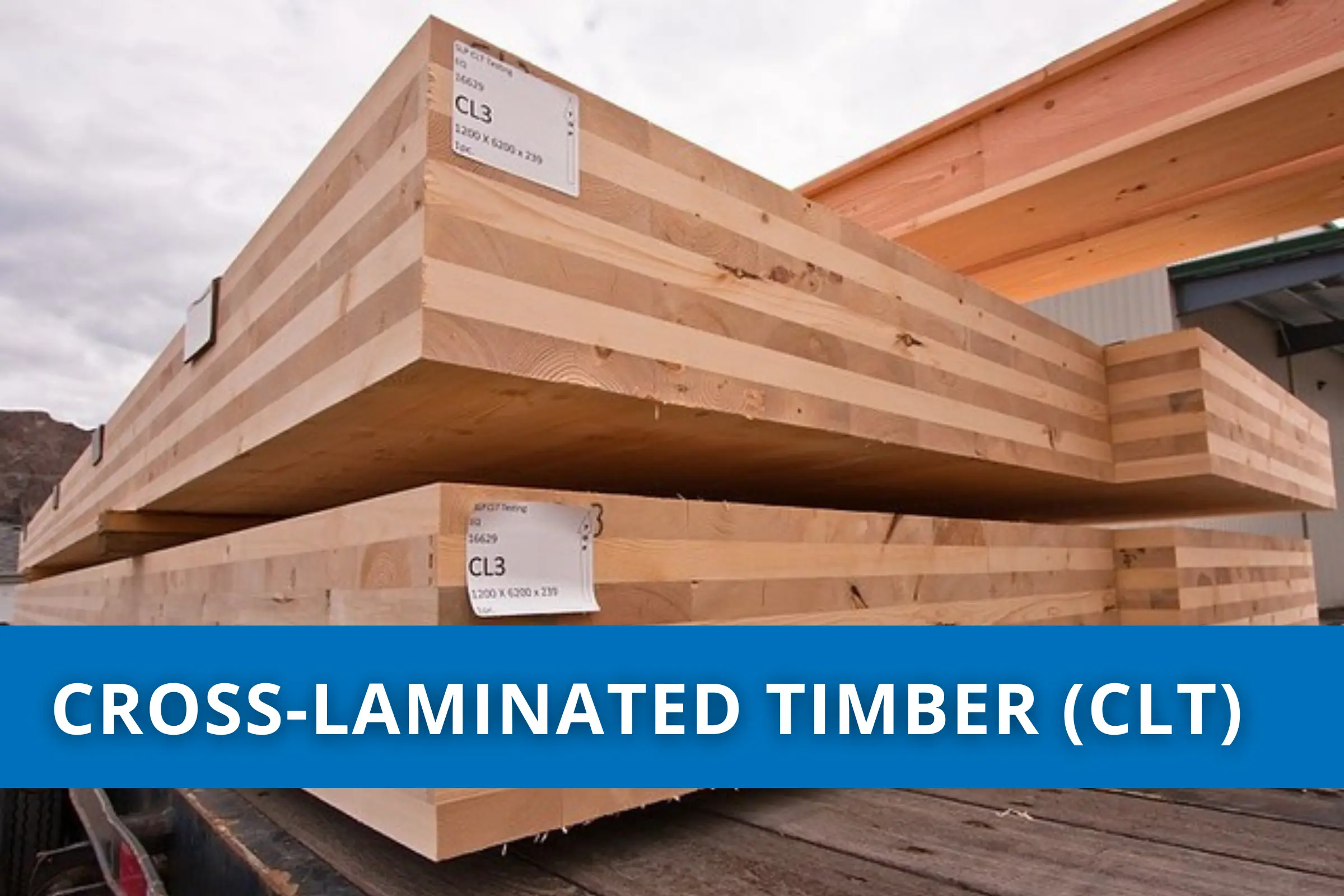image by U.S. DEPARTMENT OF AGRICULTURE
Architectural design, engineering and construction companies are now looking at the use of Cross-Laminated Timber (CLT) to replace traditional wood materials. Learn the basics of this new material, how it’s made, what it looks like and more in this article.
What is Cross-Laminated Timber?
Cross-laminated timber (CLT) is a type of engineered wood that is made by bonding layers of lumber together with adhesives.
The resulting panel is strong and stable, making it an ideal material for construction.
CLT has been used in Europe for many years, but it is only now beginning to gain popularity in the United States.
CLT is well suited for both commercial and residential construction. It can be used for load-bearing walls, floors, and roofs.
CLT panels are also acoustically and thermally insulated, which makes them ideal for use in sound studios and other sensitive environments.
One of the biggest advantages of CLT is its ability to be prefabricated off-site. This means that CLT buildings can be erected quickly and with minimal disruption to the surrounding area.
Additionally, CLT buildings have a smaller carbon footprint than traditional concrete or steel buildings.
If you are considering using CLT for your next construction project, be sure to work with a reputable manufacturer who can provide you with the necessary support and guidance.
Why is CLT a Better Choice for a Home?
Cross-laminated timber, or CLT, is quickly becoming the preferred choice for home construction. Here’s why:
1. CLT is more stable than traditional lumber. The layers of cross-laminated timber are bonded together under pressure, which makes the material less likely to warp or twist over time.
2. CLT is stronger than traditional lumber. The layers of cross-laminated timber create a material that is up to 10 times stronger than traditional lumber.
3. CLT is more energy efficient. The solid structure of CLT helps to create a tighter building envelope, which leads to lower energy costs.
4. CLT is more sustainable than traditional lumber. CLT is made from renewable wood sources, and the manufacturing process has a lower environmental impact than traditional lumber production.
5. CLT is easier to work with than traditional lumber. The dimensional stability of CLT means that it can be cut and drilled without splitting or cracking.
If you’re looking for a material that is strong, stable, and sustainable, cross-laminated timber is the right choice for your home.
CLT for Residential Construction and Design Considerations
Cross-laminated timber (CLT) is a type of engineered wood that is becoming increasingly popular in residential construction.
CLT is made by bonding layers of lumber together with adhesive and then pressing the resulting panel under heat and pressure.
This process results in a strong, stable product that can be used in a variety of applications.
CLT panels are typically used as load-bearing walls or floors in residential construction. They can also be used for roofs, but this is less common.
CLT panels are often left exposed in interior spaces, which creates a unique aesthetic.
When used in exterior applications, CLT panels are typically clad with another material such as brick or stone.
There are a few things to consider when using CLT in residential construction.
First, CLT panels are heavy and require special handling during installation.
Second, CLT is an combustible material and must be properly protected from fire if used in interior applications.
Finally, the adhesive used to bond the layers of lumber together can go off-gas over time, so good ventilation is important in rooms with CLT walls or floors.
Overall, cross-laminated timber is a versatile and sustainable material that is well suited for use in residential construction.
Also Read- 5 Easy Ways to Remove Old Wallpaper
CLTs are an Excellent Choice for Building in Coastal Areas
Cross-laminated timber (CLT) is an excellent choice for building in coastal areas. The panels are extremely strong and resistant to both wind and water damage.
Additionally, CLT panels are made from renewable wood sources, making them an environmentally friendly building material.
While CLT panels are more expensive than traditional lumber, they offer significant advantages in terms of both strength and durability.
For these reasons, CLT is becoming an increasingly popular choice for construction in coastal areas.
Furthermore, CLT panels are light and easy to work with, which makes them well-suited for construction in remote areas.
CLT Panels Will Provide a New Way of Building in Coastal Areas. Timber is a renewable resource that can be harvested without destroying other ecosystems.
Additionally, timber homes are extremely durable as well as powerful enough to withstand the force of both wind and water.
With the increasing popularity of CLT panels, building codes will be updated to ensure that these environmentally friendly panels are available to anyone who wants them.
Ultimately, CLT panels will provide an excellent way of building homes in coastal areas while simultaneously protecting the environment.
What are the Advantages of cross laminated timber?
Cross-laminated timber (CLT) is a type of engineered wood that is becoming increasingly popular in construction and is changing the way wood is used in buildings.
CLT is made by bonding layers of lumber together with adhesive to create a strong, solid panel. This makes it an ideal material for constructing walls, floors, and roofs.
CLT panels are prefabricated, which means they can be quickly and easily installed on-site. This makes construction faster and more efficient.
There are many advantages to using CLT in construction.
One of the biggest advantages is that CLT is extremely strong and durable. It has been shown to perform well in seismic and wind tests, making it an ideal material for regions that are prone to earthquakes or hurricanes.
CLT is also fire resistant and does not release toxic fumes when burned, making it a safer option than traditional wood construction.
Another advantage of CLT is that it is environmentally friendly. The production of CLT panels requires less energy than traditional lumber production methods.
Furthermore, CLT panels can be reused or recycled at the end of their lifespan. This makes them a more sustainable option than other construction materials such as concrete or steel.
CLT panels also have a very low embodied energy, meaning that they require less primary energy and natural resources to be produced.
Because CLT panels are made from wood fibers, they have excellent insulation properties while also being durable and strong.
Last but not least, CLT is fire resistant and does not release toxic fumes when burned. The use of CLT in construction has grown steadily over the past 15 years, with more than thousands of projects built or under construction around the world.
What are the disadvantages of cross laminated timber?
Cross laminated timber has a number of disadvantages, including its high cost and the fact that it is not readily available in many parts of the world.
In addition, cross laminated timber is difficult to work with and requires special equipment and skills. What is the building code for cross laminated timber?
Cross laminated timber meets building code requirements as a structural material in some states, including California, and it is also CE marked for use in Europe.
Also Read – 15 types of Concrete Defects: Causes, Prevention, Repair
Possible Issues with the Use of Cross Laminated Timber in Residential Construction and Design Considerations
Cross laminated timber (CLT) is a relatively new technology that is being used more and more in the construction of both commercial and residential buildings.
While CLT has many advantages over traditional construction methods, there are also some potential issues that should be considered when using this material.
One of the main concerns with CLT is its fire resistance. While CLT is made from layers of wood, which are naturally fire resistant, the adhesive that is used to hold the layers together can be flammable.
This means that if there is a fire in a building constructed with CLT, the entire structure could be at risk.
Another concern with CLT is its strength. While this material is very strong, it is not indestructible. If CLT is not properly designed and constructed, it could fail during an earthquake or high winds.
This could lead to serious damage to the property and injuries to those inside.
Finally, because CLT is still a relatively new technology, there is not a lot of information available on its long-term performance.
It is unclear how well CLT will stand up to the elements over time, or how easily it can be repaired if it is damaged.
All in all, CLT is a great option when used properly. However, it is not a “one size fits all” solution. For example, CLT provides excellent insulation and fire protection, but it is also heavy and difficult to work with.
If you are considering CLT as part of your construction project, be sure to consult with an experienced professional who can provide you with the best advice possible.
Choosing the Right Type of Cross Laminate Timber for Your Project Can Make a Big Difference!
When it comes to cross-laminated timber (CLT), there are a few different types to choose from. Depending on your project, one type may be better suited than another. Here is a quick guide to the different types of CLT and when you should use them:
Type I CLT is made up of boards that are all the same thickness. This makes it ideal for projects where uniformity is key, such as in load-bearing walls or floors.
Type II CLT has boards of varying thicknesses, with the thicker boards typically in the middle layer. This type is well suited for projects that need a bit more flexibility, such as curved walls or roofs.
Type III CLT is made up of boards that alternate in thickness between layers. This creates a very strong and stiff panel, making it ideal for projects that require extra strength, such as in bridge construction.
No matter what type of project you’re working on, there’s cross-laminated timber that’s perfect for the job. So do your research and pick the right one for your needs!
How is Cross-Laminated Timber Manufactured?
Cross-laminated timber (CLT) is a type of engineered wood that is increasingly being used in construction, thanks to its many advantages over traditional wood construction.
CLT is made by gluing together layers of lumber at right angles to each other, with the grain of each layer running in a different direction.
This creates a strong and stable panel that can be used for floors, walls, and roofs. CLT panels can be custom made to any size and shape, making them very versatile.
The manufacturing process for CLT primarily involves gluing together lumber, typically spruce or pine.
The boards are stacked into layers and glued together at 90-degree angles. Sometimes the layers of lumber are first cut to a uniform size.
The layers are then compressed under heat and pressure to form solid panels.
These panels can be used immediately or stored in a controlled environment until they’re ready to be assembled into the final structure.
When the project is ready to go up, each panel is placed in a specialized machine called an off-setter, which precisely positions it on the frame of the structure.
The panels are then secured together using bolts or screws, which are placed between every other layer with equal spacing on all sides.
This allows for uniform strength throughout the structure. Depending on the project, the panels can be installed using a variety of methods, including shoring and rapid-set forms.
Cross Laminated Timber Production –
Conclusion and Wrap Up
Cross-laminated timber (CLT) is a rapidly emerging technology that is changing the way wood construction is done.
CLT offers many advantages over traditional construction methods, including faster construction times, improved safety, and superior environmental performance.
With all of these benefits, it’s no wonder that CLT is becoming increasingly popular in the construction industry.
Did you like this post?
Please help us spread the word by sharing with your friends on Facebook or Twitter. And don’t forget to like our page on Facebook too!
If you have any questions or comments, please feel free to leave them below. We love hearing from you!


